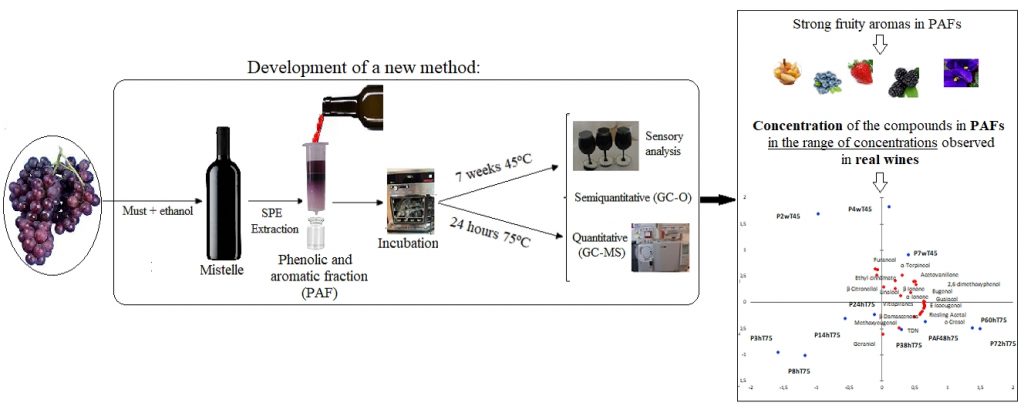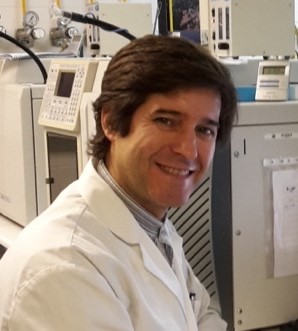By Vicente Ferreira, Purificación Hernández Orte and Yohanna Alegre
Food Res. Int., 127, 2020: 108728
https://doi.org/10.1016/j.foodres.2019.108728
The contribution of winemaking grapes to wine aroma is known to be essential and has been a hot topic in wine science for years. However, many aspects of the grape-derived wine aroma remain yet poorly understood. The paper presents a completely new methodological strategy which will be of much help for measuring the aroma potential of winemaking grapes.
The reasons for the low success in this area can be found in the complexity of the aroma precursor fractions from grape, and particularly, in the lack of adequate tools for studying such fractions. Most research is based on the indirect study of non-volatile precursor fractions extracted from grape. The problem is that these fractions are so complex that their direct analysis by HPLC-MS or GC-MS (after volatilization using different strategies) is, at the moment, of little practical utility. This is because the links between the precursor non-volatile molecules and the aroma compounds are very complex and are not known. Because of this, these precursor fractions are usually “revealed” by two major estrategies: enzymatic hydrolysis and/or harsh acid hydrolysis. Enzymatic hydrolysis is carried out with glycolitic enzymes and provides a relatively unbiased composition of the volatile molecules bound to sugars present in the fraction. The problem is that many of those volatile molecules do not have any olfactory relevance, and that some of the most relevant wine aroma molecules, such as β-damascenone, TDN or β-ionone, are not found within the aglycones. On its side, harsh acid hydrolysis, provides information about these last molecules, but destroys nearly completely all the other relevant aroma compounds (terpenols, volatile phenols, vanillins…). Best aromatic results are obtained using mild acid hydrolysis, but this takes a long time (> 2 months) and, in the conditions used in the past, there are strong evidences suggesting that there was strong aroma oxidation and deterioration during the hydrolysis.
The present paper develops a quite different strategy which makes use of three key clues: a) grapes are immediately processed in the presence of ethanol to avoid fermentation and to mimic the extraction got in red winemaking. Ethanolic musts or “mistelles” are obtained as a result; b) mistelles are further dealcoholized and extracted using 10 g-C18 cartridges and further eluted with ethanol to obtain an ethanolic fraction containing together grape polyphenols and grape aroma precursors. This fraction is known as PAF (polyphenolic and aromatic fraction); c) PAFs are further diluted with water containing tartaric acid to form wine-like models (13% ethanol v/v, pH 3.5) and these reconstituted PAFs (rPAFs) are aged in strict anoxic conditions for different times and temperatures. Anoxic conditions are essential and are obtained by processing samples in a glove box containing less than 1 ppm of Oxygen and using completely air tight aging containers.

The extraction method finally obtained in the paper makes it possible to recover more than 85% of grape polyphenols and all aroma precursors except those of DMS, which are lost during sample preparation. It has been also found, that if the aging is carried out at 45°C, at least 7 weeks are required to observe good aroma development. However, the fractions so obtained showed intense fruity aromas reminding some of the most appreciated wine aroma nuances. At 75°C, in just 1 day, there is a satisfactory aroma development. The aroma fractions developed were studied by Gas Chromatography-Olfactometry and GC-MS. Results confirmed that hydrolyzates obtained at 75ºC in just 1 day (rPAF24hT75), are sensorily, chemically and olfactometrically, very close to those obtained after 7 weeks at 45°C (rPAF7wT45).

At least 32 different odorants at levels potentially relevant from the sensory point of view were identified in the hydrolyzates. Odorants can be classified into five categories:
- Lipid derivatives, including Z-3-hexenal, 1-octen-3-one, (Z)-1,5-octadien-3-one, Z-3-hexenol, E-2-octenal, Z-2-nonenal, E-2-nonenal, (E,Z)-2,6-nonadienal, (E,E)-2,4-nonadienal, γ-decalactone and massoia lactone.
- Volatile phenols and vanillins, including guaiacol, cresols, eugenol, 2,6-dimethoxyphenol, E-isoeugenol and vanillin.
- Nor-isoprenoids and terpenes, including linalool oxide (and/or dihydromyrcenol), linalool, TDN, β-damascenone and β-ionone.
- Amino acid derivatives, including methional and sotolon.
- Benzenoids and miscellaneous compounds, including β-phenylethanol, ethyl cinnamate, furaneol, 3-mercaptohexanol and three unidentified compounds.
Odorants from categories 1 and 4 will be likely transformed by yeast, so that they may not reach wine. However, odorants in categories 1, 3 and 5 will be essential for the development of wine aroma. The presence of 3-mercaptohexanol is surprising, because for the first time it is suggested that this important aroma compound could be formed from the precursor without the concourse of yeast.

Vicente Ferreira
Mail: vferre@unizar.es
Webpage: http://laae.unizar.es/
Scopus id. 7102726672
Researcher ID D-4277-2014
Orcid Code 0000-0002-4353-2483
Full Professor of Analytical Chemistry at the University of Zaragoza and head of the Laboratory for Aroma Analysis and Enology (LAAE). Specialist in the chemical analysis of the molecules responsible for the different perceptions related to the odor, flavor and taste, and in the integration of the chemical information to interpret the sensory perception. This knowledge has been primary applied to wine flavor, a field in which LAAE is world leader. He has authored more than 210 regular scientific papers, some of them of very high impact (h=51 WoS; =51 Scopus, =60 Google Scholar), 12 book chapters, edited 1 book and written numerous scientific divulgation papers. He has supervised 27 PhD Thesis and holds two patents as inventor.

Purificación Hernández Orte
Mail: puhernan@unizar.es
Webpage: http://laae.unizar.es/
Orcid Code 0000-0003-3641-9164
My main research line is to develop methods to achieve the chemical characterization of the oenological quality of grapes by measuring their content in aroma precursors as well as to study the influence that microorganisms have on the formation of wine aroma from these precursors. She has coauthored more than 60 regular scientific papers, some of them of very high impact (h=26 WoS and h=29 Google Scholar).

Yohanna Alegre
Mail: yohannaalegre@unizar.es
Webpage: http://laae.unizar.es/
Scopus Author ID: 57140579400
Orcid Code 0000-0002-5516-1448
PhD student in Chemistry in the University of Zaragoza. She is interested in the knowledge about the aroma precursors present in grapes. She is nowadays finishing her PhD and working in the development of a methodology for the determination of the aromatic potential of vinification grapes.
She has coauthored 5 scientific JCR articles and 1 scientific divulgation paper. h-index=2/3 (scopus/GoogleScholar), 14/18 citations (Scopus/GoogleScholar). 10 contributions in scientific symposiums.

